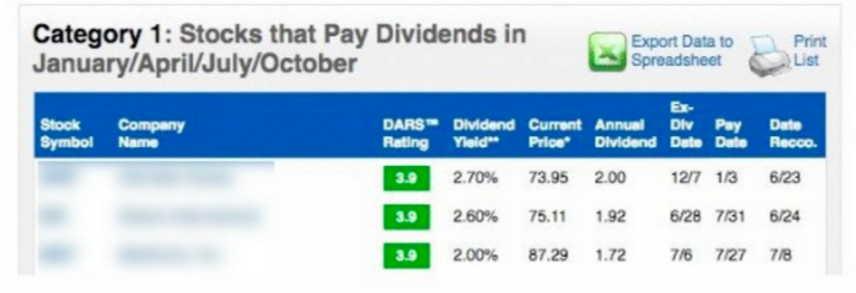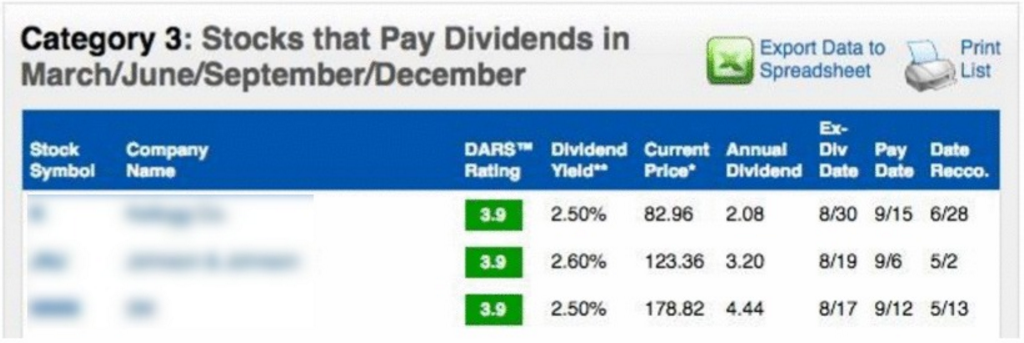How you can use Dividends to pay off your mortgage
Many investors love dividends, and for good reason. When a company pays a dividend to shareholders, it provides investors with steady income that they can use however they please. Dividends allow investors extra monthly or quarterly income, which can help pay for regular expenses like food, utility bills, or even a mortgage.
Dividend.com has a tool that Premium members can access that provides additional information on how to pay off a mortgage with dividends.
Mortgage payments repay both interest due on the loan and the principal of the loan. Most loans are based on the concept of equated monthly installments, or EMI. Mortgages with EMI are structured so that the borrower makes a set monthly payment that pays off the loan in full in a specified period of time.
Since a mortgage carries a monthly payment, in similar fashion, investors can craft a portfolio of dividend-paying stocks that provide income every month. While most dividend stocks do not make distributions on a monthly basis, instead of making dividend payments four times each year, investors can diversify a portfolio to invest in dividend stocks to match the same frequency.

Jan/April/July/October Payments

February/May/August/November Payments

March/June/September/December Payments

Click Go Premium to start your 14-Day FREE trial and get access to our monthly income generator tool.
These are just a few examples of the many high-quality, blue-chip dividend stocks that have long histories of paying and even raising their dividends over time. For an example of how to create a portfolio of dividend stocks to pay a mortgage, assume a homeowner has a $400 per month EMI. In that case, an investor should at least invest enough to generate $400 per month in dividend income. That investor should spread his or her portfolio across stocks with dividend payments in each of the three above categories so that the investor receives at least $400 across all 12 months. One might prefer to invest even more than that to generate a level of dividend income above the necessary $400 threshold—for example, $500-$600 per month in dividend income. This would be especially useful to pay down the loan sooner in order to reduce the overall amount of interest paid on the loan.
It is important to be flexible with the investment portfolio to be able to react to changes in dividend income.
Reacting to Changes in Dividend Income or EMI
Under the EMI structure, the borrower is allowed to make only one fixed payment per month. That provides a great deal of certainty, but at the same time, dividends fluctuate depending on the health of the underlying companies invested in. Companies that generate rising sales and profits over time have the ability to raise dividends; unfortunately, the opposite is true as well. Companies in decline often cut their dividends to preserve cash flow.
As a result, it is important to be nimble enough to react to changes in portfolio dividend income. If an investor successfully invests in companies that raise dividends each year, that investor will see their monthly income rise above the requirements to satisfy the EMI. Let’s return to the previous example of an investor that owns stocks in companies that provide him or her with $400 in monthly income to satisfy the EMI. If those dividend stocks raise their dividends by 10% per year, that investor will see their monthly income rise to $440 per month in one year. This growth can be significant. Assuming 10% annual dividend growth, in five years, that investor’s dividend portfolio will generate $644 per month.
With the additional dividend income, it is financially beneficial for the investor to use the additional dividend income to make payments above the EMI. That is because higher payments earlier on in the course of the loan will reduce the amount of interest the borrower pays over the course of a 15-year or 30-year loan. Moreover, paying more than the EMI to prepay the principal amount makes a great deal of financial sense because of the interest rate environment.
In the current climate, short-term interest rates are near historic lows. Savers with money in the bank in short-term accounts like savings or certificates of deposit are receiving little to no interest. It is true that long-term rates are low as well, but most 30-year mortgages are priced between 3.5% and 4.5% right now. As a result, the optimal strategy would be for an investor to use additional dividend income to pay down the mortgage principal, therefore reducing the interest paid over the course of the loan, because that money would earn almost nothing in savings.
Separately, investors must also prepare for decreases in dividend income. If the sample portfolio suffers a drop in dividend income below the $400 EMI, it makes sense to invest more in dividend stocks to get back to the $400 minimum threshold. That is particularly necessary if the EMI increases.
The Bottom Line
With interest rates where they are, investors are not compensated adequately to hold large cash balances. Idle cash is better served to invest in dividend stocks, pay down mortgage principal, or both. Some investors may be skittish about investing in dividend-paying stocks, given the volatility that comes from investing in the stock market. However, from an income perspective, dividend stocks are a great place to invest right now to pay off a monthly mortgage, because interest rates are extremely low.





